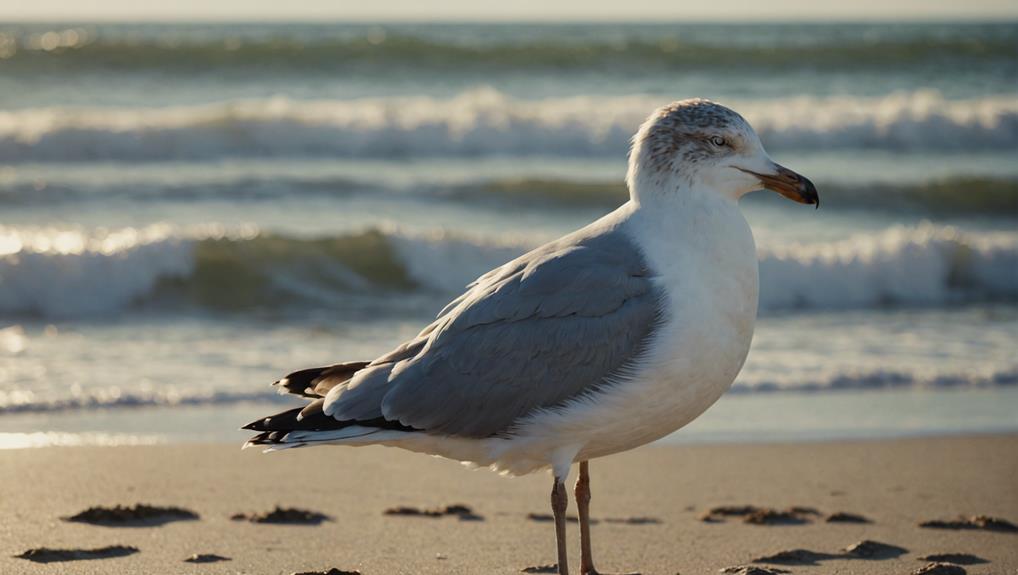When a seagull bows its head, it communicates significant social cues. This behavior can signal submission and respect within the hierarchy, helping to maintain social order and reduce conflicts. During courtship, head bowing shows interest and aids in bonding between potential mates. Moreover, this gesture may indicate relaxation and contentment, observed when gulls feel safe and at ease. Foraging seagulls also bow their heads to better inspect the ground for food. Understanding these behaviors provides a glimpse into the complex social dynamics and well-being of seagulls. To uncover more intriguing aspects of seagull interactions, continue your exploration.
Understanding Gull Communication
Seagulls employ a variety of behaviors, including head bowing, to communicate and navigate their social interactions. Gull communication is rich and complex, with head bowing serving as a key gesture. This behavior can indicate submission, helping to avert conflicts by signaling non-aggressive intentions. For instance, when one gull bows its head to another, it often aims to show that it does not wish to engage in a fight, thereby maintaining peace within the flock.
Moreover, head bowing plays a significant role during courtship rituals. In these intimate moments, a gull may bow its head to a potential mate, indicating interest and fostering a bond. This gesture helps to establish a connection and trust between the pair, which is important for successful mating and nesting.
Understanding these subtle cues is important for interpreting the social dynamics within a group of seagulls. By recognizing when and why gulls bow their heads, observers can gain insights into their behaviors and interactions.
Whether in showing submission or participating in courtship, head bowing is a versatile and crucial component of gull communication, reflecting their complex social structure and relationships.
Submission and Respect
Head bowing among seagulls serves as a clear indication of submission and respect within their social hierarchy. This particular behavior is an essential aspect of their communication, allowing seagulls to navigate complex social interactions smoothly.
When a seagull bows its head, it signifies submission to a dominant or higher-ranking bird, effectively acknowledging the other bird's authority and status within the group. This act of respect is critical in maintaining harmony among seagulls, as it helps to avoid potential conflicts or aggression.
By showing deference, a seagull communicates its recognition of another's dominance, reducing the likelihood of confrontations over resources like food, nesting sites, or territory. In diverse social interactions, such as feeding or territorial disputes, head bowing plays a significant role in the dynamics of seagull communities.
It allows them to establish and maintain order without resorting to physical altercations. Understanding the significance of these subtle gestures provides valuable insight into the intricate social structures and communication methods of seagulls.
Establishing Hierarchies

In seagull communities, the act of bowing one's head plays a pivotal role in establishing and reinforcing social hierarchies. This behavior is a significant signal in the complex social interactions of gulls, where each bird's position within the group hierarchy is essential.
When a gull bows its head, it often indicates submission or respect towards a dominant bird, showcasing the intricate balance of dominance and submission that dictates their social structure.
During interactions, a dominant gull may assert its authority, prompting a submissive gull to lower its head. This gesture of deference helps to avoid potential conflict or aggression, maintaining harmony within the flock.
The bowed head signifies a recognition and acknowledgment of higher-ranking members, ensuring that each bird understands its place in the pecking order.
Relaxation Behaviors
Beyond their role in social hierarchies, bowing the head can also be an indicator of relaxation and contentment among seagulls. This behavior, often observed during peaceful moments or when the gull is resting, serves as a non-verbal cue that the bird feels at ease.
Understanding these relaxation behaviors can provide valuable insights into the well-being of these fascinating creatures.
When a seagull bows its head, it is a clear sign of relaxation and contentment. This head-bowing gesture, a natural behavior, typically occurs when the gull feels safe and secure in its environment. Observing such actions can inform bird watchers and researchers about the comfort levels of seagulls in different settings.
To summarize the key points about seagulls' relaxation behaviors:
- Head-bowing: A common non-verbal cue indicating the gull's relaxed state.
- Peaceful Moments: This behavior is often seen when the gull is at rest or in a calm environment.
- Sign of Relaxation: Head-bowing in seagulls signals that they feel safe and content.
- Comfort Levels: Observing these behaviors can help assess the well-being of the birds.
These insights underscore the importance of recognizing and interpreting the subtle non-verbal cues exhibited by seagulls.
Foraging and Feeding

Seagulls frequently bow their heads while foraging, an action that improves their ability to locate and capture food items efficiently. This behavior is a critical component of their feeding strategy, allowing them to inspect the ground closely for potential prey or food sources.
By adopting a bowed head posture, seagulls can better spot and pick up small insects, crustaceans, fish, or scavenged food. This meticulous inspection helps them identify hidden or buried food items that might otherwise go unnoticed.
The act of bowing the head during feeding not only facilitates the detection of food but also signifies alertness and readiness. Seagulls must remain vigilant and prepared to grab food quickly, especially in competitive environments where multiple birds might be foraging simultaneously. This head posture allows them to peck at or probe the ground efficiently, maximizing their chances of securing a meal.
Furthermore, this behavior underscores the adaptability and intelligence of seagulls in their natural habitat. Their ability to modify head posture to improve foraging success is an excellent example of how these birds have evolved intricate methods to survive and thrive in diverse environments.
Courtship Displays
While head bowing is a key behavior during foraging, it also plays a significant role in the courtship displays of seagulls. This intriguing action is a critical part of their courtship behavior, serving multiple purposes during mating interactions. Head bowing acts as a form of non-verbal communication, enabling seagulls to convey diverse signals to potential mates without vocalizing.
Here are four key aspects of head bowing in courtship displays:
- Submission and Peaceful Intentions: Bowing the head can indicate submission or a desire to avoid conflict, creating a peaceful environment for courtship.
- Respect and Acknowledgment: This gesture may also be a sign of respect or acknowledgment towards a potential partner, fostering mutual recognition.
- Precursor to Other Behaviors: Head bowing often leads to other courtship behaviors, such as vocalizations and wing displays, progressing the mating ritual.
- Establishing Social Bonds: By engaging in head bowing, seagulls establish vital social bonds, which are necessary for successful mating interactions.
These behaviors highlight the complexity and importance of non-verbal communication in seagull courtship. Through head bowing, seagulls navigate the delicate dance of attracting and securing a mate, ensuring the continuation of their species.
Interaction With Predators

Head bowing in seagulls often serves as a strategic response to potential predators, signaling submission and readiness to avoid conflict. This behavior is primarily a defensive posture aimed at reducing aggression from larger birds or predators. When a seagull bows its head, it communicates a critical intention, thereby lowering the chances of a direct confrontation. This act of submission can be vital for survival in the wild, where avoiding unnecessary battles is fundamental.
Moreover, head bowing can indicate a heightened state of alertness. By lowering their heads, seagulls can cautiously assess their surroundings without making direct eye contact, which might otherwise provoke a predator. This posture allows the bird to remain ready to take flight at a moment's notice if the threat level escalates. The subtle communication involved in bowing the head showcases the seagull's ability to navigate complex social and environmental interactions.
In essence, head bowing in seagulls serves as a multifaceted tool for communicating deference and maintaining alertness in the presence of potential threats. This behavior underscores the seagull's adaptability and nuanced approach to survival, highlighting their sophisticated methods of interaction and conflict avoidance.
Observing Body Language
Understanding the nuances of body language in seagulls, including the act of bowing their heads, is crucial for interpreting their social interactions and hierarchical structures accurately. Observing body language in seagulls reveals much about their communication methods and social hierarchy.
Head bowing in seagulls can serve several purposes, each providing insight into their behavior.
- Submission and Respect: A seagull bowing its head may indicate submission, showing respect or acknowledgment of a dominant individual within the group, thereby reinforcing social hierarchy.
- Non-Threatening State: Head bowing can also signify a relaxed or non-threatening state during social interactions, helping to maintain peace within a colony.
- Courtship Displays: During mating seasons, seagulls may bow their heads as part of intricate courtship displays, using body language to attract potential mates.
- Non-Verbal Communication: Seagulls use head bowing to communicate non-verbally with other gulls, conveying messages without vocalizing.
The duration and intensity of head bowing vary, depending on context and individuals involved. By closely observing these behaviors, researchers and enthusiasts can gain deeper insights into seagull behavior, improving our understanding of their complex social structures and communication methods.
Frequently Asked Questions
What Do Different Seagull Noises Mean?
Seagull noises have significant meanings. Mew calls, which sound like a cat's meow, are used to gather chicks or warn intruders.
Choke calls, resembling choking sounds, often precede mew calls and serve as a warning to potential threats.
These vocalizations are vital for communication within the seagull community, helping to maintain social order, protect territories, and safeguard the safety of their young.
Understanding these sounds offers insight into seagull behavior.
What Is the Mating Ritual of Seagulls?
The mating ritual of seagulls is a fascinating display of behaviors designed to attract and bond with a mate. It involves head bowing to show submission, vocalizations, and specific body postures.
Moreover, seagulls engage in mutual preening, wing displays, and shared feeding activities. These rituals not only communicate readiness for mating but also strengthen the pair bond, ensuring successful reproduction within their colonies.
Why Do Herring Gulls Bow Their Heads?
Herring gulls bow their heads as a significant part of their courtship behavior, particularly during pair bonding and mating rituals. This gesture communicates submission or affection towards a mate, reinforcing their bond.
The head bowing is a display of intimacy and trust, vital for strengthening their relationship. By engaging in this behavior, herring gulls guarantee effective communication and cooperation, which is pivotal for their successful mating and future offspring.
What Does It Mean When Seagulls Laugh?
When seagulls 'laugh,' they are actually producing their distinctive 'mew' call, which serves multiple purposes. This sound acts as a warning to potential intruders and also signals the gathering of chicks.
Moreover, it plays a vital role in courtship and territorial defense. Accompanied by a forward posture and sometimes a 'choke' call, this vocalization is essential for seagull communication and social interactions.

